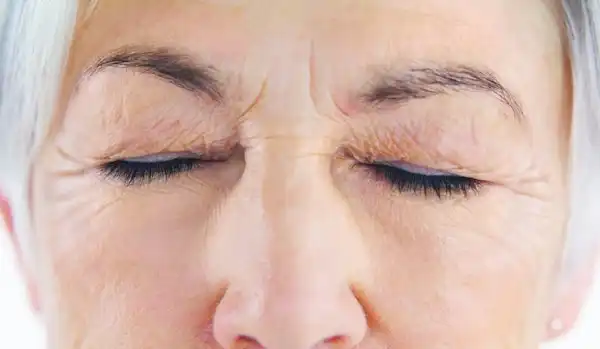Crepey skin looks like thin, wrinkled paper and can be a big worry for many. It’s different from regular wrinkles because it covers bigger areas. This makes the skin look fragile and delicate, especially under the eyes and on the upper inner arms.
But don’t worry, there are ways to make crepey skin less noticeable. You can use special skincare products or try professional treatments. This guide will show you how to fight crepey skin and keep your skin looking young and smooth.
Understanding why crepey skin happens is key. It’s caused by aging, UV rays, and other factors. By knowing this, you can take steps to keep your skin healthy and elastic.
By following the right strategies, you can improve your skin’s texture and look. This will make you feel more confident and beautiful.
Understanding What Causes Crepey Skin

Crepey skin is a common issue as people age. It happens when collagen and elastin fibers break down. These fibers are key to keeping our skin firm and young. Sun damage speeds up this breakdown, making skin thin, dry, and wrinkled.
The Role of Collagen and Elastin Loss
As we get older, our bodies make less collagen. This protein keeps our skin firm and elastic. Elastin, which lets skin stretch and bounce back, also decreases with age. This loss of these proteins leads to crepey, thin skin.
Impact of UV Radiation on Skin Texture
UV radiation from the sun is a big cause of crepey skin. UV rays harm skin cells, stopping collagen and elastin production. This damage makes skin thin and wrinkled, showing the crepey look.
Age-Related Skin Changes
Our skin changes with age, leading to crepey skin. Less oil, hormonal changes, and aging itself reduce skin elasticity. This results in thin, wrinkled skin.
Essential Prevention Strategies for Skin Health

To keep your skin looking young and healthy, you need to act early. Focus on sun protection, staying hydrated, and using skincare with antioxidants.
Sun damage is a big reason for crepey skin. UV rays harm collagen and elastin, making skin look older. Use sunscreen with SPF 30 or higher and wear protective clothes. Try to stay indoors when the sun is strongest.
Keeping your skin hydrated is key. Use moisturizers with glycerin and hyaluronic acid. Drinking water and eating foods with lots of water helps too.
Antioxidants protect your skin from harm. Eat lots of colorful fruits and veggies. Also, use skincare with vitamins C, green tea, and resveratrol to fight aging.
Exercise and managing stress help your skin stay healthy. These steps can make your skin look younger for longer.

The Science Behind Crepey Skin Formation
Crepey skin is a common issue as people age. It looks like thin, delicate paper. This happens due to aging, environmental damage, and hormonal changes. Knowing the science behind it can help prevent crepey skin.
Natural Aging Process Effects
Our skin changes a lot as we get older. It makes less collagen and elastin, which are key for firm, elastic skin. This loss makes our skin look wrinkled and crepey, especially on the face, neck, and arms.
Environmental Factors Impact
Things like UV rays from the sun harm our skin’s collagen and elastin. Pollution, smoking, and too much alcohol also speed up skin aging. These factors can make skin look crepey sooner.
Hormonal Influences on Skin Texture
Hormonal changes, like during menopause, affect our skin a lot. Lower estrogen levels mean less moisture and elasticity. This makes crepey skin look worse.

Top Professional Treatments and Procedures
Are you tired of crepey skin? There are many professional treatments to help. Fractional laser therapy (Fraxel) and ultrasound therapy (Ulthera) boost collagen. This tightens the skin and makes it smoother.
Cryolipolysis (CoolSculpting) targets stubborn areas with crepey skin. Fillers like Radiesse or Sculptra add volume and smooth wrinkles. Topical retinoids from dermatologists can also work well.
For crepey skin, see a dermatologist or skincare specialist. They’ll figure out what you need. You might get laser therapy, ultrasound, or a mix of treatments. With the right care, you can get smoother, younger-looking skin.
Natural Remedies and Lifestyle Changes
Get back your youthful, smooth skin with natural remedies and lifestyle changes. Eating a skin-friendly diet, staying hydrated, exercising regularly, and managing stress can help. These steps can reduce the look of crepey skin.
Dietary Modifications for Skin Health
Eat foods high in vitamins C and E, omega-3 fatty acids, and antioxidants. These help make collagen, fight inflammation, and protect against aging. Eat lots of fruits, veggies, whole grains, and lean proteins for healthy skin.
Hydration and Exercise Benefits
Drinking enough water is key for keeping your skin elastic and moist. This prevents dryness that makes crepey skin worse. Also, drink moisturizing oils like coconut or olive oil. Exercise boosts circulation and skin health, making your skin look young and bright.
Sleep and Stress Management
Good sleep and stress control are also important for your skin. Try to sleep 7-9 hours a night for skin renewal. Do stress-reducing activities like meditation, yoga, or deep breathing to protect your skin from cortisol damage.
Effective Skincare Products and Ingredients
Getting your skin to look young again starts with the right products. Look for formulas with retinoids, alpha hydroxy acids, peptides, and hyaluronic acid. These ingredients are key to fighting crepey skin.
Retinoids, a vitamin A derivative, boost cell turnover and collagen production. This helps smooth and firm your skin. Over-the-counter retinol can start showing results in three months with regular use. Prescription-strength retinoids might work faster but start slow to avoid irritation, especially if your skin is dry or sensitive.
Alpha hydroxy acids, like glycolic or lactic acid, gently exfoliate. They improve texture and reduce fine lines and wrinkles. Peptides, made of amino acids, tell your skin to make more collagen. This boosts elasticity and plumpness.
Hyaluronic acid is crucial for crepey skin, as it deeply hydrates and keeps moisture in. This minimizes signs of aging. For the arms or legs, use body moisturizers with ammonium lactate. They can greatly improve skin texture.
Always do a patch test before adding new products to your routine. Start slow to see how your skin reacts. With the right skincare, you can achieve smoother, younger-looking skin.
Daily Skincare Routine Recommendations
Creating a good skincare routine is key to keeping your skin healthy and looking young. It helps reduce the look of crepey skin. By following a daily routine, you can feed, protect, and refresh your skin. This helps fight the signs of aging.
Morning Skincare Steps
Start your day with a gentle clean to get rid of dirt and prepare your skin. Pick a mild cleanser that won’t dry out your skin. Then, use a moisturizer with hydrating stuff like hyaluronic acid to make your skin plump.
Don’t forget to apply sunscreen with SPF 30 or higher. This protects your skin from UV rays, which can make skin look crepey.
Evening Care Protocol
In the evening, focus on fixing and refreshing your skin. Cleanse again to remove makeup, dirt, and oil from the day. Use a serum with retinol or other active ingredients to boost collagen and cell turnover.
This helps keep your skin elastic and smooth. End with a moisturizer to keep your skin hydrated and support its natural barrier.
Weekly Treatment Schedule
Also, do a weekly exfoliating treatment to get rid of dead skin cells. Use products with alpha-hydroxy acids like glycolic or lactic acid. They help resurface your skin and make it look smoother and younger.
Adjust how often you do this based on how your skin reacts. Remember, your skincare routine should fit your skin type and needs. Talk to a dermatologist or skincare expert for advice. They can help make sure your skincare regimen is right for crepey skin, cleansing, moisturizing, and exfoliation.
Targeting Different Body Areas
When tackling crepey skin, focusing on specific areas is crucial. The neck and décolletage need special care with serums and gentle exfoliation. For the under-eye area, hydrating eye creams can reduce the look of crepe-like texture.
Body lotions with firming ingredients like retinol or glycolic acid can tighten and smooth the arms. Sometimes, professional treatments like ultrasound therapy are needed for crepey arm skin. Always be gentle when treating crepey skin to prevent further damage.
Crepey skin is more common in women and often starts in the 30s on areas like the arms and legs. A consistent skincare routine with exfoliating, hydrating, and protecting steps can help keep skin healthy and youthful from head to toe.
Conclusion
Managing crepey skin needs a mix of prevention, treatments, and lifestyle changes. You might not get rid of it completely, but you can make it look and feel better. Regular visits to a dermatologist help you create a plan that fits you and track your progress.
Keeping your skin healthy is a long-term job. It means protecting your skin, boosting collagen and elastin, and living a healthy life. With the right professional advice and skincare, you can reduce crepey skin and get a younger look.
Your skin’s health shows how well you’re doing overall. By focusing on long-term care and making smart choices, you can keep your skin looking great as you age. Start this journey and show off your commitment to a vibrant, healthy look.
Discover more nail trends:
- The Ultimate Guide to Niacinamide Skincare Products for Radiant Skin
- Mastering Your Morning Skincare Routine for Radiant Skin
- Skin Care Goals for 2024: 7 Essential Guidelines to Follow This Year
- Follow us on Facebook





